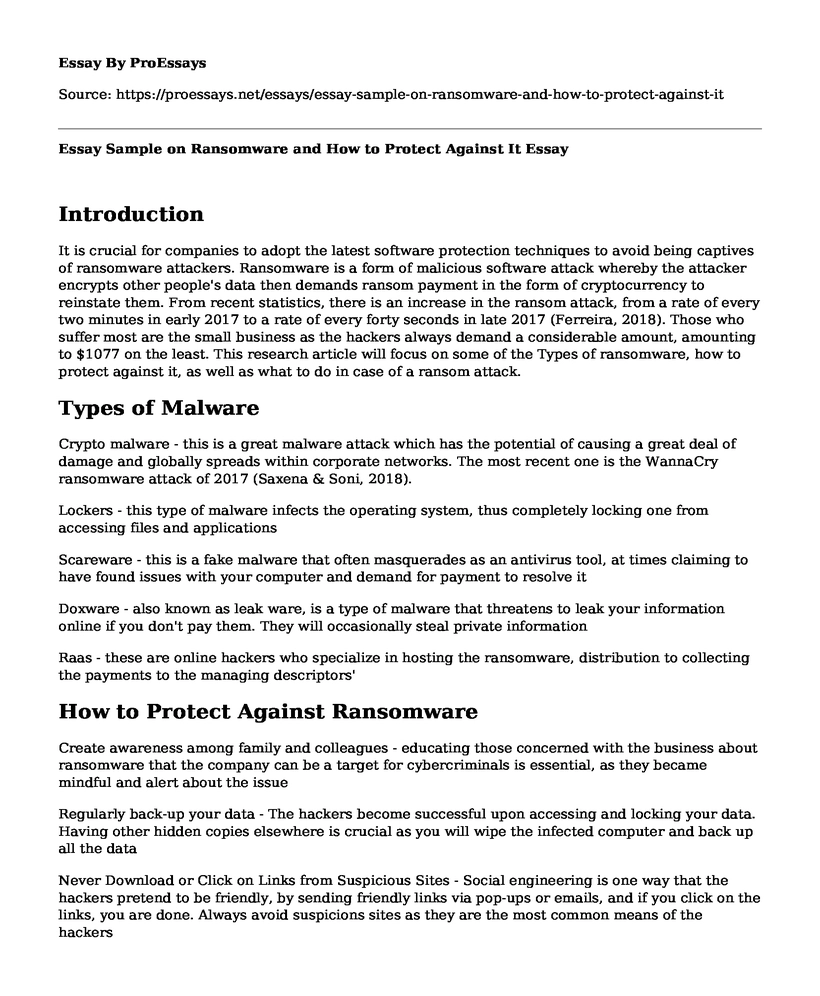Introduction
It is crucial for companies to adopt the latest software protection techniques to avoid being captives of ransomware attackers. Ransomware is a form of malicious software attack whereby the attacker encrypts other people's data then demands ransom payment in the form of cryptocurrency to reinstate them. From recent statistics, there is an increase in the ransom attack, from a rate of every two minutes in early 2017 to a rate of every forty seconds in late 2017 (Ferreira, 2018). Those who suffer most are the small business as the hackers always demand a considerable amount, amounting to $1077 on the least. This research article will focus on some of the Types of ransomware, how to protect against it, as well as what to do in case of a ransom attack.
Types of Malware
Crypto malware - this is a great malware attack which has the potential of causing a great deal of damage and globally spreads within corporate networks. The most recent one is the WannaCry ransomware attack of 2017 (Saxena & Soni, 2018).
Lockers - this type of malware infects the operating system, thus completely locking one from accessing files and applications
Scareware - this is a fake malware that often masquerades as an antivirus tool, at times claiming to have found issues with your computer and demand for payment to resolve it
Doxware - also known as leak ware, is a type of malware that threatens to leak your information online if you don't pay them. They will occasionally steal private information
Raas - these are online hackers who specialize in hosting the ransomware, distribution to collecting the payments to the managing descriptors'
How to Protect Against Ransomware
Create awareness among family and colleagues - educating those concerned with the business about ransomware that the company can be a target for cybercriminals is essential, as they became mindful and alert about the issue
Regularly back-up your data - The hackers become successful upon accessing and locking your data. Having other hidden copies elsewhere is crucial as you will wipe the infected computer and back up all the data
Never Download or Click on Links from Suspicious Sites - Social engineering is one way that the hackers pretend to be friendly, by sending friendly links via pop-ups or emails, and if you click on the links, you are done. Always avoid suspicions sites as they are the most common means of the hackers
Continually Update Your Software - Whenever there is an update, be sure to update it. In Ukraine, a cloud-based software provider became the ransom distributor when its IT staff forgot to update their OS server.
Also, ensure that you protect/keep an eye on your network by using trusted technologies such as a next-generation firewall. Ensure to use the sophisticated scanning technologies to detect the malware as traditional one is from unknown and untrusted sources.
Be aware and updated - Be attentive on the threat intelligence by always being awake on information from organizations such as Talos to be updated on emerging cybersecurity threats and information security.
What to Do After Being Infected By a Ransomware
Once you are infected, disconnect from the internet immediately as being online will be a significant ground for ransomware activation. After that, get in touch with the IT staff to roll back the system as soon as possible. Besides, if it doesn't provide the option, never pay the ransom as there are high chances that they might not unlock it after the pay (McBride et al., 2018).
Conclusion
Ransomware is gaining grounds day by day, and always targeting big companies as well as the small business. Always be sure to practice the prevention ways such as regular backdating of data, being aware and updating of virus information, avoiding suspicious links and sites, and also regular software update. Once you have become a victim, ensure that you immediately disconnect from the internet and consult IT, staff. Do not fall a victim and pay the ransom as the chances of being reinstated is minimal. Hence, everyone connected to a business or company should keep watch and be sensitive to the various ransomware attacks.
References
Ferreira, A. (2018, October). Why Ransomware Needs A Human Touch. In 2018 International Carnahan Conference on Security Technology (ICCST) (pp. 1-5). IEEE.
McBride, T., Townsend, A., Ekstrom, M., Lusty, L., & Sexton, J. (2018, September). Data Integrity: Recovering from Ransomware and Other Destructive Events. In 2018 IEEE Cybersecurity Development (SecDev) (pp. 140-140). IEEE.
Saxena, S., & Soni, H. K. (2018, February). Strategies for Ransomware Removal and Prevention. In 2018 Fourth International Conference on Advances in Electrical, Electronics, Information, Communication, and Bio-Informatics (AEEICB) (pp. 1-4). IEEE.
Cite this page
Essay Sample on Ransomware and How to Protect Against It. (2022, Dec 13). Retrieved from https://proessays.net/essays/essay-sample-on-ransomware-and-how-to-protect-against-it
If you are the original author of this essay and no longer wish to have it published on the ProEssays website, please click below to request its removal:
- Digital Technology Make Us More Lonely - Essay Sample
- Local City Sites Configuration Paper Example
- Accounting Information Systems and Their Impact on the Development of Corporate Financial Performance
- Essay Sample on Careers and Certifications in Cybersecurity
- Interesting Things for a Computer Programmer - Essay Sample
- Hacking: Strategies, Techniques and Capabilities of Hacker Organizations - Essay Sample
- Free Research Paper Sample on Uncovering Truths Through Qualitative Research: Confirmability, Dependability & More







